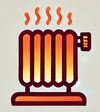Want to keep your home warm while saving on energy bills? Start by sealing drafts around windows and doors, using a programmable thermostat, and maintaining your heating system regularly. These simple steps can significantly enhance your home’s energy efficiency.
Plus to these basics, consider layering your clothing and using area rugs to retain heat. By implementing these energy-efficient heating tips, you’ll not only create a cozy space but also contribute to a greener environment. Let’s dive deeper into how you can optimize your heating without very costly.
Energy-Efficient Heating Tips
- Thermostat Settings: Set your thermostat between 68 and 70 degrees Fahrenheit while you’re home. Lower it when you sleep or leave. This simple act can save energy. Using a programmable or smart thermostat makes this easier. You can adjust settings remotely and automate changes for maximum savings.
- Maintenance and Upgrades: Clean or replace your HVAC filters regularly. Proper airflow increases efficiency and cuts energy costs by 5-15 percent. Schedule annual tune-ups for your HVAC system. Regular maintenance enhances efficiency and comfort. If your system is old, consider an upgrade. ENERGY STAR certified models can reduce your annual energy bills by nearly $140.
Implementing these strategies ensures you maintain comfort in your home while also keeping energy costs low.
Understanding Energy Efficiency
Energy efficiency in heating plays a vital role in saving money and improving comfort. Knowing its importance helps you make informed choices.
Importance of Energy Efficiency in Heating
Heating your home represents about 29% of your energy bill. Improving your heating system’s efficiency reduces costs and environmental impact. Efficient systems emit fewer pollutants, contributing to a cleaner environment. By upgrading to energy-efficient models, you can enjoy these benefits while enhancing your home’s comfort.
How It Affects Your Energy Bills
Every degree your thermostat is set can significantly impact your energy bills. Lowering your thermostat by just a few degrees saves money each month. For instance, if you lower it by 5 degrees while you’re away or sleeping, you might save around 10% on heating costs. Using a programmable thermostat automates this process, ensuring optimal settings even when you’re not home. Making these adjustments leads to noticeable reductions in your monthly expenses.
Common Heating Systems
Understanding your heating options helps you make informed choices. Here’s a look at the most common systems and their features.
Pros and Cons of Different Systems
- Conventional Furnaces:
- Pros: They’re widely available and relatively inexpensive to install. You can fuel them with natural gas, oil, or electricity.
- Cons: They can be inefficient without proper maintenance. Regular upkeep is essential for optimal performance.
- Heat Pumps:
- Pros: Heat pumps are highly efficient, especially in mild climates. They provide both heating and cooling while needing less maintenance.
- Cons: Their effectiveness drops in very cold temperatures. The initial installation cost might be higher compared to other systems.
- Boilers and Radiators:
- Pros: These systems use hot water or steam for heating. They distribute warmth evenly through radiators.
- Cons: Installation can be costly, and maintenance requires attention to prevent leaks and ensure efficiency.
Choosing the Right System for Your Home
When selecting a heating system, consider these factors:
- Home Size: Larger homes may require a more powerful system, while smaller spaces benefit from compact options.
- Local Climate: In warmer regions, a heat pump can be ideal. In colder climates, conventional furnaces or boilers often provide better heating.
- Energy Efficiency: Look for ENERGY STAR certified models. They save on energy bills and reduce environmental impact.
- Budget: Factor in upfront costs and long-term savings. Some systems may have higher initial prices but lower operational costs.
Evaluate these aspects carefully. Your choice impacts energy bills, comfort, and efficiency. Adjust according to your unique needs.
Practical Energy-Efficient Heating Tips
Energy-efficient heating involves smart choices. Focus on insulation, thermostat settings, and regular maintenance for optimal results.
Insulation and Sealing Gaps
Seal air leaks around doors and windows. These gaps waste heat. Use caulk or weatherstripping to close these openings. Inspect ducts too. Sealing and insulating ducts can boost efficiency by up to 20%. This is crucial for ductwork in attics, crawlspaces, and basements. Apply duct sealant or metal-backed tape on seams. Wrap the ducts in insulation to retain heat. Insulate your home effectively. Proper insulation in walls, floors, and ceilings minimizes heat loss.
Thermostat Management
Manage your thermostat wisely. Set it between 68 and 70 degrees Fahrenheit when you’re home. Lower the setting at night or when you leave. A programmable or smart thermostat makes this easy. Reducing your home’s temperature by 5 degrees can save about 10% on your heating bill. Take advantage of these devices for consistent savings.
Regular Maintenance of Heating Systems
Maintain your heating system regularly. Check and replace HVAC filters monthly. Schedule annual tune-ups to ensure efficiency. Clean systems improve performance and comfort. Consider upgrades to ENERGY STAR certified models. These units significantly cut energy bills and maintain optimal heating levels. Regular maintenance not only extends the life of your system, but it also enhances safety.
Utilizing Technology
Technology can boost your home’s energy efficiency with ease. By implementing smart devices, you can save on heating costs while staying comfortable.
Smart Thermostats
Smart thermostats adjust your home’s temperature automatically. These devices learn your habits. They lower the temperature when you’re away and raise it when you’re home. Set your thermostat to a lower temperature at night or when you leave for work. This can save around $100 each year on heating bills if you use ENERGY STAR certified models. Some smart thermostats even connect to your smartphone. You can control the temperature from anywhere. Many also include sensors that detect when you’re home, making adjustments as needed.
Energy Monitoring Devices
Energy monitoring devices track your home’s energy use in real-time. These tools provide insight into how much energy you consume. You can identify which appliances use the most energy. Some devices even send alerts when energy usage spikes. With this information, you can make informed decisions to reduce consumption. For example, you might unplug devices that draw power when not in use. Monitoring can lead to smarter energy usage and lower bills. These devices help you actively manage your home’s energy efficiency.
Conclusion
Implementing energy-efficient heating tips can transform your home into a cozy sanctuary while cutting down on energy costs. By sealing drafts using programmable thermostats and maintaining your heating system, you’re not just enhancing comfort but also making a positive impact on the environment.
Every small adjustment you make can lead to significant savings on your energy bills. Whether it’s adjusting your thermostat or upgrading to an ENERGY STAR certified model, these steps empower you to take control of your energy usage.
Embrace these strategies for a warmer home and a greener future. Your wallet and the planet will thank you.







